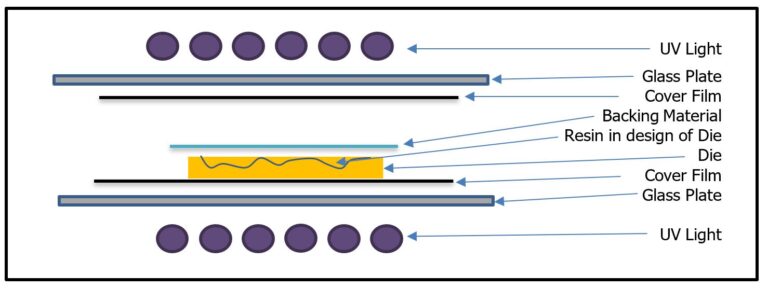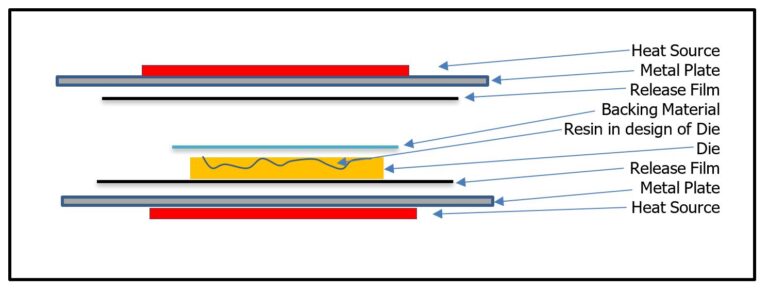How to Make Embossing Dies In-House
A quick and low cost solution to making Embossing dies is by using Photopolymer Plates.
Being able to make Die’s and counterforces in-house can make life easier and reduce cost, especially when short runs and quick turnarounds are concerned. Photopolymer plates are a useful option that can be used to solve a problem.
- Correcting mistakes on urgent orders.
- Pre-production prototype / samples.
- Advertising and marketing proofs.
- Design changes.
- Short run work.
- Testing
- And much more….
To start with, we would recommend photopolymer dies for more bolder, less detailed and simpler designs. Fine lines will easily break, so reducing run length, therefore best to avoid if possible. However more sophisticated designs are possible but are subject to hit or miss and trial and error. In addition the quality of embossing may not reach the required quality when compared to metal dies. With experience and artwork experimentation you should be able make dies with much more sophisticated designs. Like with most situations, experience makes a difference and over time, you would be able to make reasonably complex dies by creating artwork to suit the materials capabilities. Photopolymer dies are more suited for embossing paper and low density thin card. The dies are easily prone to breakage and wear and so only suitable for low runs particularly on hand operated hot stamping machines and slow running semi-automatic machines.
If your print / emboss setup has multiple stations then using different thickness polymer plates with its matching counterforces on each station can turn a 2½D polymer plate system into a nearly 3D multi-level embossed image. Just as in colour separation you have to create a different layer for each embossed height / depth level. Using the method the transitions between different levels may be more jiggered so design your project with that in mind.
There are many types of photopolymer plates and it is very important to select the right type and the right thickness to get the best results. You should only use steel backed high temperature photopolymer plates and specific ones that are suitable for embossing. Once selected and you are happy with the plate, then the thickness of the plate is the variable issue. The plates backing material is usually the same thickness across the relevant range of overall plate thickness. Typically for most applications you rarely emboss over 1.2mm unless embossing required is very pronounced. We recommend plate thicknesses from around 0.8mm up to around 1.75mm overall thickness. The average embossing relief is around 0.7mm with embossing varying from 0.1 to 1.2mm. You may need to experiment with different plate thicknesses and may require a few different thickness plates and used depending on the job on hand.
When washing photopolymer plates, the water wash types are highly recommended, as they are easier to work with. If you want to manipulate the depth of the relief, you are able to wash by hand using a mohair pad. Instead of washing the plate to its floor, you are able to wash unevenly to create high and low relief areas, which can be used to simulate a 3D type effect when used with a reciprocating counterforce. Photopolymer plates gives you the opportunity to experiment and be creative in effects not previously tried, when having the die made out, because of cost and time delays due to inflexibility.
Photopolymer plates can also be used to make matching counterforces for photopolymer dies. Particularly suited for bold and simple designs. The artwork for the counterforce needs to be slightly enlarged and adjusted so when the counter is made it will mate correctly to emboss with no surface damage on the substate when embossing. Artwork enlargement and modification is a slow and is still a hit or miss as specially on more complex designs. However it will be easier and quicker to make a counterforce off a photopolymer die using our standard counterforce materials. Photopolymer dies can be mounted on a thicker base to bring it to the required overall thickness your machines are normally set to. You may require a number of different base thicknesses depending on the different Photopolymer plate thickness you would be using.
We recommend machined Brass, Aluminium, Copper, Magnesium or even Steel as base plates. Base plates can also be made of Acrylic, Nylon and other similar plastics but plastics are subject to cracking, breaking and or compression so are not ideal but usable for short runs and where quality may not be an issue.
To make your own dies, we recommend our PPM range of Photopolymer plates available in A4 sheet size as standard in and in various thicknesses.


